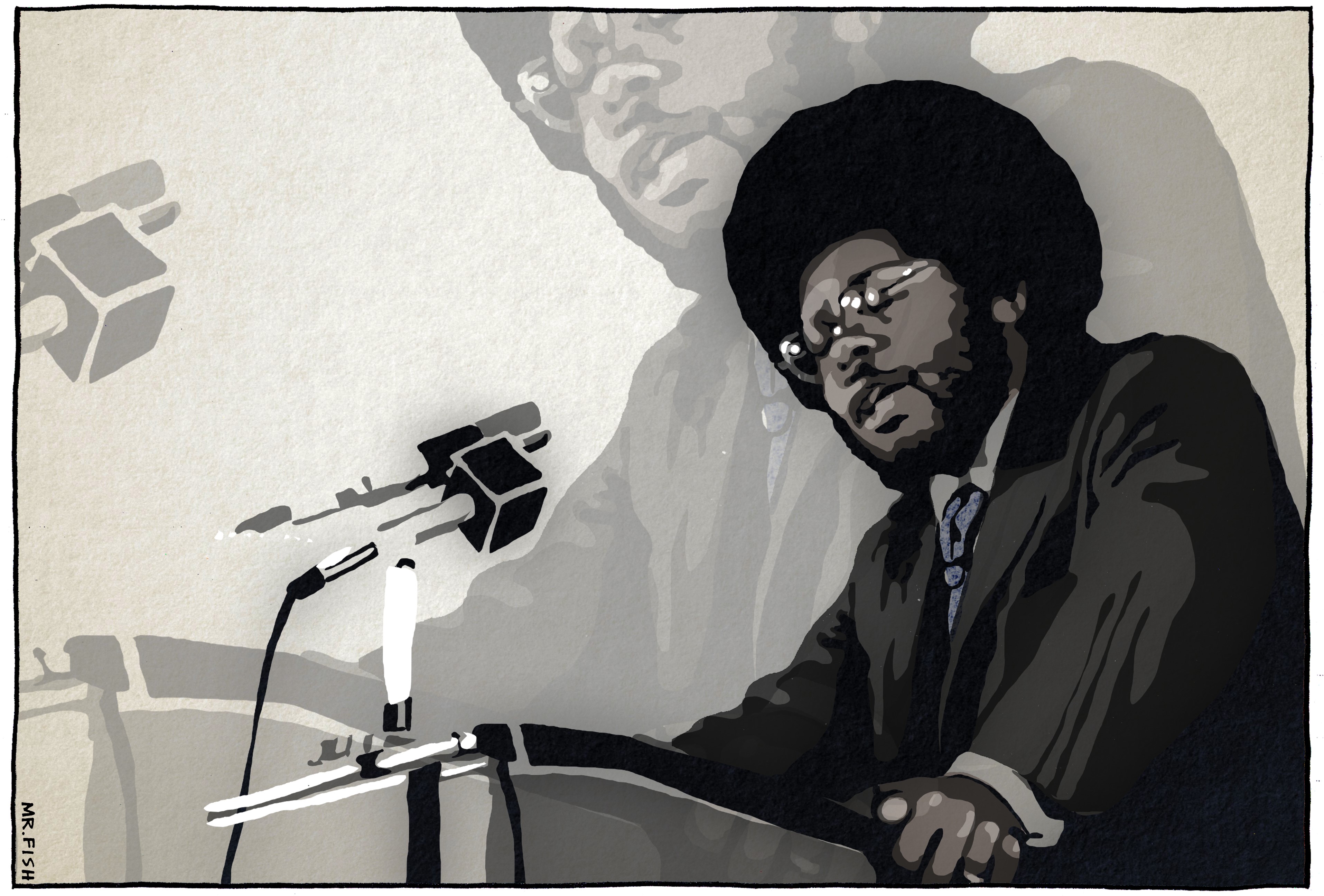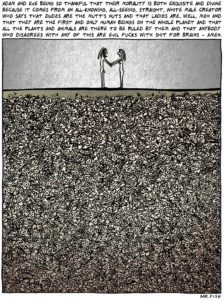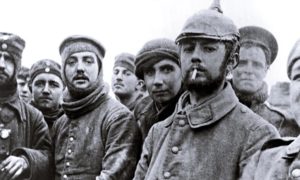The Heresy of White Christianity
James H. Cone, the father of black liberation theology, understood that the privileged can never grasp religion's true essence. Mr. Fish / Truthdig
Mr. Fish / Truthdig
There are, as Cornel West has pointed out, only two African-Americans who rose from dirt-poor poverty to the highest levels of American intellectual life—the writer Richard Wright and the radical theologian James H. Cone.
Cone, who died in April, grew up in segregated Bearden, Ark., the impoverished son of a woodcutter who had only a sixth-grade education. With an almost superhuman will, Cone clawed his way up from the Arkansas cotton fields to implode theological studies in the United States with his withering critique of the white supremacy and racism inherent within the white, liberal Christian church. His brilliance—he was a Greek scholar and wrote his doctoral dissertation on the Swiss theologian Karl Barth—enabled him to “turn the white man’s theology against him and make it speak for the liberation of black people.” God’s revelation in America, he understood, “was found among poor black people.” Privileged white Christianity and its theology were “heresy.” He was, until the end of his life, possessed by what the theologian Reinhold Niebuhr called “sublime madness.” His insights, he writes, “came to me as if revealed by the spirits of my ancestors long dead but now coming alive to haunt and torment the descendants of the whites who had killed them.”
“When it became clear to me that Jesus was not biologically white and that white scholars actually lied by not telling people who he really was, I stopped trusting anything they said,” he writes in his posthumous memoir, “Said I Wasn’t Gonna Tell Nobody: The Making of a Black Theologian,” published in October.
“White supremacy is America’s original sin and liberation is the Bible’s central message,” he writes in his book. “Any theology in America that fails to engage white supremacy and God’s liberation of black people from that evil is not Christian theology but a theology of the Antichrist.”
White supremacy “is the Antichrist in America because it has killed and crippled tens of millions of black bodies and minds in the modern world,” he writes. “It has also committed genocide against the indigenous people of this land. If that isn’t demonic, I don’t know what is … [and] it is found in every aspect of American life, especially churches, seminaries, and theology.”
Cone, who spent most of his life teaching at New York City’s Union Theological Seminary, where the theological luminaries Paul Tillich and Reinhold Niebuhr preceded him, was acutely aware that “there are a lot of brilliant theologians and most are irrelevant and some are evil.”
Of the biblical story of Cain’s murder of Abel, Cone writes: “… [T]he Lord said to Cain, ‘Where is your brother Abel?’ He said, ‘I don’t know; am I my brother’s keeper?’ And the Lord said, ‘What have you done? Listen: your brother’s blood is crying out to me from the ground!’ ” Cain, in Cone’s eyes, symbolizes white people, as Abel symbolizes black people.
“God is asking white Americans, especially Christians, ‘Where are your black brothers and sisters?’ ” Cone writes. “And whites respond, ‘We don’t know. Are we their keepers?’ And the Lord says, ‘What have you done to them for four centuries?’ ”
The stark truth he elucidated unsettled his critics and even some of his admirers, who were forced to face their own complicity in systems of oppression. “People cannot bear very much reality,” T.S. Eliot wrote. And the reality Cone relentlessly exposed was one most white Americans seek to deny.
“Christianity is essentially a religion of liberation,” Cone writes. “The function of theology is that of analyzing the meaning of that liberation for the oppressed community so they can know that their struggle for political, social, and economic justice is consistent with the gospel of Jesus Christ. Any message that is not related to the liberation of the poor is not Christ’s message. Any theology that is indifferent to the theme of liberation is not Christian theology. In a society where [people] are oppressed because they are black, Christian theology must become Black Theology, a theology that is unreservedly identified with the goals of the oppressed community and seeking to interpret the divine character of their struggle for liberation.”
The Detroit rebellion of 1967 and the assassination of Martin Luther King Jr. a year later were turning points in Cone’s life. This was when he—at the time a professor at Adrian College, a largely white college in Adrian, Mich.—removed his mask, a mask that, as the poet Paul Laurence Dunbar wrote, “grins and lies.”
“I felt that white liberals had killed King, helped by those Negroes who thought he was moving too fast,” he writes. “Even though they didn’t pull the trigger, they had refused to listen to King when he proclaimed God’s judgment on America for failing to deal with the three great evils of our time: poverty, racism, and war. The white liberal media demonized King, accusing him of meddling in America’s foreign affairs by opposing the Vietnam War and blaming him for provoking violence wherever he led a march. White liberals, however, accepted no responsibility for King’s murder, and they refused to understand why Negroes were rioting and burning down their communities.”
“I didn’t want to talk to white people about King’s assassination or about the uprisings in the cities,” he writes of that period in his life. “[I]t was too much of an emotional burden to explain racism to racists, and I had nothing to say to them. I decided to have my say in writing. I’d give them something to read and talk about.”
Cone is often described as the father of black liberation theology, although he was also, maybe more importantly, one of the very few contemporary theologians who understood and championed the radical message of the Gospel. Theological studies are divided into pre-Cone and post-Cone eras. Post-Cone theology has largely been an addendum or reaction to his work, begun with his first book, “Black Theology and Black Power,” published in 1969. He wrote the book, he says, “as an attack on racism in white churches and an attack on self-loathing in black churches. I was not interested in making an academic point about theology; rather, I was issuing a manifesto against whiteness and for blackness in an effort to liberate Christians from white supremacy.”
Cone never lost his fire. He never sold out to become a feted celebrity.
“I didn’t care what white theologians thought about black liberation theology,” he writes. “They didn’t give a damn about black people. We were invisible to their writings, not even worthy of mention. Why should I care about what they thought?”
“After more than fifty years of working with, writing about, talking to white theologians, I have to say that most are wasting their time and energy, as far as I am concerned,” he writes, an observation that I, having been forced as a seminary student to plow through the turgid, jargon-filled works of white theologians, can only second. Cone blasted churches, including black churches that emphasize personal piety and the prosperity gospel, as “the worst place to learn about Christianity.”
His body of work, including his masterpieces “Martin & Malcolm & America” and “The Cross and the Lynching Tree,” is vital for understanding America and the moral failure of the white liberal church and white liberal power structure. Cone’s insight is an important means of recognizing and fighting systemic and institutionalized racism, especially in an age of Donald Trump.
“I write on behalf of all those whom the Salvadoran theologian and martyr Ignacio Ellacuría called ‘the crucified peoples of history,’ ” Cone writes in his memoir. “I write for the forgotten and the abused, the marginalized and the despised. I write for those who are penniless, jobless, landless, all those who have no political or social power. I write for gays, lesbians, bisexuals, and those who are transgender. I write for immigrants stranded on the U.S. border and for undocumented farmworkers toiling in misery in the nation’s agricultural fields. I write for Palestinians in the Gaza Strip, on the West Bank, and in East Jerusalem. I write for Muslims and refugees who live under the terror of war in Iraq, Afghanistan, and Syria. And I write for all people who care about humanity. I believe that until Americans, especially Christians and theologians, can see the cross and the lynching tree together, until we can identify Christ with ‘recrucified’ black bodies hanging from lynching trees, there can be no genuine understanding of Christian identity in America, and no deliverance from the brutal legacy of slavery and white supremacy.”
The cross, Cone reminded us, is not an abstraction; it is the instrument of death used by the oppressor to crucify the oppressed. And the cross is all around us. He writes in “The Cross and the Lynching Tree”:
The cross is a paradoxical religious symbol because it inverts the world’s value system, proclaiming that hope comes by way of defeat, that suffering and death do not have the last word, that the last shall be first and the first last. Secular intellectuals find this idea absurd, but it is profoundly real in the spiritual life of black folk. For many who were tortured and lynched, the crucified Christ often manifested God’s loving and liberating presence within the great contradictions of black life. The cross of Jesus is what empowered black Christians to believe, ultimately, that they would not be defeated by the “troubles of the world,” no matter how great and painful their suffering. Only people stripped of power could understand this absurd claim of faith. The cross was God’s critique of power—white power—with powerless love, snatching victory from the jaws of defeat.
Present-day Christians misinterpret the cross when they make it a nonoffensive religious symbol, a decorative object in their homes and churches. The cross, therefore, needs the lynching tree to remind us what it means when we say that God is revealed in Jesus at Golgotha, the place of the skull, on the cross where criminals and rebels against the Roman state were executed. The lynching tree is America’s cross. What happened to Jesus in Jerusalem happened to blacks in Arkansas, Mississippi, and Kentucky. Lynched black bodies are symbols of Christ’s body. If we want to understand what the crucifixion means for Americans today, we must view it through the lens of mutilated black bodies whose lives are destroyed in the criminal justice system. Jesus continues to be lynched before our eyes. He is crucified wherever people are tormented. That is why I say Christ is black.
Every once in a while, when Cone expressed something he thought was particularly important, he would say, “That’s Charlie talking.” To know Cone was to know Charlie and Lucy, his parents, who wrapped him and his brothers in unconditional love that held at bay the dehumanizing fear, discrimination and humiliation that came with living in Jim and Jane Crow Arkansas. He, like poet and novelist Claude McKay, said that what he wrote was “urged out of my blood,” adding “in my case the blood of blacks in Bearden and elsewhere who saw what I saw, felt what I felt, and loved what I loved.”
The essence of Cone was embodied in this radical love, a love that was not rooted in abstractions but the particular reality of his parents and his people. The ferocity of his anger at the injustice endured by the oppressed was matched only by the ferocity of his love. He cared. And because he cared, he carried the hurt and pain of the oppressed, the crucified of the earth, within him. As a boy, after dark, he waited by the window for his father to return home, knowing that to be a black man out on the roads in Arkansas at night meant you might never reach home. He spent his life, in a sense, at that window. He wrote and spoke not only for the forgotten, but also in a very tangible way for Charlie and Lucy. He instantly saw through hypocrisy and detested the pretentions of privilege. He never forgot who he was. He never forgot where he came from. His life was lived to honor his parents and all who were like his parents. He had unmatched courage, integrity and wisdom; indeed he was one of the wisest people I have ever known.
Cone was acutely aware, as Charles H. Long wrote, that “those who have lived in the cultures of the oppressed know something about freedom that the oppressors will never know.” He reminded us that our character is measured by what we have overcome. Despair, for him, was sin.
“What was beautiful about slavery?” Cone asks in his memoir. “Nothing, rationally! But the spirituals, folklore, slave religion, and slave narratives are beautiful, and they came out of slavery. How do we explain that miracle? What’s beautiful about lynching and Jim Crow segregation? Nothing! Yet the blues, jazz, great preaching, and gospel music are beautiful, and they came out of the post-slavery brutalities of white supremacy. In the 1960s we proclaimed ‘Black is beautiful!’ because it is. We raised our fists to “I’m Black and I’m Proud,’ and we showed ‘Black Pride’ in our walk and talk, our song and sermon.”
He goes on:
We were not destroyed by white supremacy. We resisted it, created a beautiful culture, the civil rights and Black Power movements, which are celebrated around the world. [James] Baldwin asked black people “to accept the past and to learn to live with it.” “I beg the black people of this country,” he said, shortly after “Fire” [“The Fire Next Time”] was published, “to do something which I know to be very difficult; to be proud of the auction block, and all that rope, and all that fire, and all that pain.”
To see beauty in tragedy is very difficult. One needs theological eyes to do that. We have to look beneath the surface and get to the source. Baldwin was not blind. He saw both the tragedy and the beauty in black suffering and its redeeming value. That was why he said that suffering can become a bridge that connects people with one another, blacks with whites and people of all cultures with one another. Suffering is sorrow and joy, tragedy and triumph. It connected blacks with one another and made us stronger. We know anguish and pain and have moved beyond it. The real question about suffering is how to use it. “If you can accept the pain that almost kills you,” says Vivaldo, Baldwin’s character in his novel Another Country, “you can use it, you can become better.” But “that’s hard to do,” Eric, another character, responds. “I know,” Vivaldo acknowledges. If you don’t accept the pain, “you get stopped with whatever it was that ruined you and you make it happen over and over again and your life has—ceased, really—because you can’t move or change or love anymore.” But if you accept it, “you realize that your suffering does not isolate you,” Baldwin says in his dialogue with Nikki Giovanni; “your suffering is your bridge.” Singing the blues and the spirituals is using suffering, letting it become your bridge moving forward. “For, while the tale of how we suffer, and how we are delighted, and how we may triumph is never new, it always must be heard,” Baldwin writes in his short story “Sonny’s Blues.” “There isn’t any other tale to tell, and it’s the only light we’ve got in all this darkness.”
“I would rather be a part of the culture that resisted lynching than the one that lynched,” Cone writes at the end of the book. “I would rather be the one who suffered wrong than the one who did wrong. The one who suffered wrong is stronger than the one who did wrong. Jesus was stronger than his crucifiers. Blacks are stronger than whites. Black religion is more creative and meaningful and true than white religion. That is why I love black religion, folklore, and the blues. Black culture keeps black people from hating white people. Every Sunday morning, we went to church to exorcize hate—of ourselves and of white racists.”
There will come difficult moments in our own lives, moments when we are faced with an impulse, driven by fear or self-interest or simple expediency, to turn away at the sight of suffering and injustice. We will hear the cries of the oppressed and want to shut them out. We will count the cost to our careers, our reputations and perhaps our security, for to truly stand with the oppressed is to be treated like the oppressed. But a force greater than our own will compel us to kneel down and pick up the cross. The weight will cut into our shoulders. Our step will slow. Our breathing will become labored. We will be condemned by the powerful and ignored or reviled by the indifferent. But we will demand justice. And when we do, we will say to ourselves, “That’s Cone talking.”
Your support matters…Independent journalism is under threat and overshadowed by heavily funded mainstream media.
You can help level the playing field. Become a member.
Your tax-deductible contribution keeps us digging beneath the headlines to give you thought-provoking, investigative reporting and analysis that unearths what's really happening- without compromise.
Give today to support our courageous, independent journalists.






You need to be a supporter to comment.
There are currently no responses to this article.
Be the first to respond.